Kevin K. Yue, Lisa Y. Law, Hiu Ling Chan, Jade B. Chan, Elaine Y. Wong, Theresa F. Kwong, Eva Y. Wong
Introduction
University education in the 21st century is not only restricted to academic development but also for whole-person development including residential education. HKBU has taken an innovative lead in the region and involved different university professionals like resident master, staff from the Centre for Holistic Teaching and Learning and the Office of Student Affairs as well as former hall tutor and hall resident to revise the existing residential student leadership training programme to introduce a new training element using AR mLearning. Newly appointed hall tutors were arranged to perform an AR-Hall Trail using a Mobile App called ‘AR-Learn’ (this App was originally called ‘Mobxz’ at the time of conducting this study) as part of the Induction Training Programme within their familiar hall environment. Through scanning of respective QR codes participants had to follow instructions given on the scenario-driven story-line interfaces within the ‘AR-Learn’ App and made responsive inputs at different pre-assigned locations during the trail. This study was part of a government-funded project titled ‘Reinforcing the Importance of Academic Integrity and Ethics in Students through Blended Learning–a Deployment of Augmented Reality Applications’ from the University Grants Committee of Hong Kong in which the objective of the project is to create a blended learning environment by combining mobile technology and AR that motivates students to learn, engage, and share knowledge on academic integrity and ethics. More details could be found on http://ar-learn.com website.
Even before the recent launch of Pokémon Go, AR has gained its popularity over the past years (Li, 2010; Johnson, Smith, Willis, Levine, & Haywood, 2011), however, relatively few research has been conducted on exploring how the use of location-aware with context-sensitive AR mLearning technologies could better enhance residential leadership training for university students. Therefore, this study was begun with a pilot AR-Hall Trail as an experiment (described in section 4.1) to try out the appropriateness of using context-sensitive mobile App design before its actual run for a group of newly appointed hall tutors in AY 2015-16 as part of their Induction Training Programme to personalize their ethical thinking upon their roles and responsibilities. Through the pilot AR-Hall Trail, a number of constructive recommendations were received from a former hall tutor and a hall resident, based on their previous experience of living in the hall of residence. Findings collected from the pilot AR-Hall Trail had provided us with very insightful suggestions for the eventual design of the AR-Hall Trail. Different quantitative and qualitative results collected during the learning trails, and interpretations were made to assess any change in the participants’ ethical thinking before and after the actual AR-Hall Trail. Towards the end of service period of these hall tutors, focus group interviews were also conducted to evaluate whether the impact of the AR-Hall Trail was sustainable.
Background
Since 2002 HKBU has invested substantial amount of resources to promote residential education as an integral part of her holistic approach to higher education. Currently, there are a total of 1,770 resident places available for full-time undergraduate students. In addition, four halls of residence, named after four prominent Chinese figures, were established to cultivate a “living-learning” hall environment. Residential education is therefore part of the whole-person development of students which contributes to part of 7 HKBU Graduate Attributes, namely Citizenship, Knowledge, Learning, Skills, Creativity, Communication and Team work.
There is a “Hall Life Education Team” to look after the four halls of residence which includes cultivating the development of respective hall cultures, organizing joint-hall programmes as well as providing general administrative support. The “Hall Life Education Team” consists of four resident masters, four resident coordinators and two staff from the Office of Student Affairs. A group of senior year (i.e. 3rd or 4th year) students are recruited every year as hall tutors of each hall to act as team builders, peer counsels, floor managers, programme assistants and supporters of residents’ positive behavior on the floor they are being assigned. All hall tutors are directly under the supervision of the respective resident coordinators. The “Hall Life Education Team” aims to strike a balance among the blissful hall life, good personal development and effective academic study among residents. With the help of the hall tutors, the team organizes various hall life activities aim at strengthening residents’ own attributes and self-management, fostering multi-cultural exchanges among residents and broadening their views. It is therefore important for those appointed hall tutors to understand their roles and responsibilities through various designed indoor and outdoor activities in the Induction Training Programme which is usually held during the summer vacation before they assume their responsibility in the following academic year. The service contract for hall tutor appointment is usually ten months, from July to May in the following year. With the increasing popularity of AR technologies, the “Hall Life Education Team” introduced an innovative AR-Hall Trail using the mobile App ‘AR-Learn’ in the AY2014-15 Induction Training Programme for newly appointed hall tutors. The intention of the AR-Hall Trail was to create a more meaningful and interesting learning experience for the participants, with an aim to reinforce and internalize their prior understanding of the ethical concepts that they learned in the classroom setting.
[Source: HKBU website (http://www.hkbu.edu.hk)].
Literature Review
Augmented Reality (AR)
AR is characterized by the incorporation of digital information including images, video, and audio into real-world spaces. AR aims to blend the reality with virtual environment, allowing users to interact with both physical and digital objects. With these technologies, students would be able to transport to any imaginable location across the known environment and transform the delivery of knowledge and empowering students to engage in deeper learning
(Johnson et al., 2016, p.40). In addition, the responsive interactivity of AR enables student to construct broader understandings based on interactions with virtual objects. Students would be greatly motivated and their learning skills improved confidently with the use of appropriate course content having rich contextual settings that mirrors the real-world situations, via the application of AR technology in which new knowledge could be applied (p.40-41).
Because of this advanced technology, AR could engage and empower students’ deeper learning by transporting students to any imaginable location and transforming the delivery of knowledge (Johnson et al., 2016, p.40). AR could be applied to advance our understanding of what is real, and thus providing an interface which proposes an artificial environment that offers more explicit information regarding real events (Hugues, Fuchs & Nannipieri, 2011). Different studies had shown that AR systems could provide motivating, entertaining, and engaging environments conducive for learning. Furthermore, students find their learning more attractive, stimulating, and exciting with the integration of AR applications as it provides effective and efficient supports for the users (Lee, 2012, p.19). Reynolds, Walker and Speight (2010) noted that many students appreciate the contextual information offered by the mobile device which encourages them to ask more questions.
Context-aware and Location-based Technologies
The two applications of this AR-Hall Trail that derive from a pedagogical perspective are (1) context-aware and (2) location-based.
The context information used in designing the AR-Hall Trail was very much scenario driven and related to participants’ daily life as hall tutors. Abowd et al. (1999) suggested that a system was context-aware if it used context to provide relevant information and/or services to the user, where relevancy depended on the user’s task. Context, as explained by Brown et al. (2010, p.5), was that “the formal or informal setting in which a situation occurred; it could include many aspects or dimensions, such as location, time, personal and social activity, resources, and goals and task structures of groups and individuals”. To optimize the development and implementation of this context-aware and location-based learning on abstract ethical topics, the methodology employed in the study echoed with what Lave and Wenger (1991) suggested that learning must not be abstract and out of context. It should be situated, and taken place within the context, activity, and culture in which it occurred as a “legitimate peripheral participation” process. By making appropriate personal responses on their smartphone devices, participants exchanged their thinking by interacting with their mobile devices. Lave and Wenger (1991) pointed out that social communication and interaction were significant parts of situated learning. In addition, construction and deployment of information technology through a serious game could enable students to take on various roles in different scenarios and gained a deeper appreciation of ethics issues (McKenzie & McCalla, 2009). The learning context used in this study had applied what Sharipova & McCalla (2013) suggested that ethical thinking by itself involved many metacognitive activities such as reorganizing the complexities of his/her situations, anticipating the consequences of actions, considering the effect of actions upon others etc.
Situated Learning & Constructivist Learning
Two interdependent theoretical frameworks of 1) situated learning theory; and 2) constructivist learning theory were being employed in this study as all learning took place within participants’ familiar hall environment. The outcome of this AR-Hall Trail was a result of interactions among the people, places, objects, processes, and culture within and relative to that given context (Brown, Collins, & Duguid, 1989).
An authentic lesson should provide students with a real-world situation in which they could define their own problem. Students could relate better if the situation is current and in the media spotlight. According to the constructivist learning theory, this is an extremely important part of a strong educational process. Students need to be able to relate their own life experiences to the topics that they are learning. All students come into a learning situation with some prior knowledge. Thus, offering students the opportunity to apply this knowledge to a real situation could provide them with a sense of accomplishment. When this occurs, a student could then be engaged within a lesson or activity and feel the need to explore new knowledge and skills that are, in fact, selected by him/her. (Strimel, 2014, p.10)
Whole-Person Education at HKBU
HKBU understands that education is far more than just simply providing students with professional knowledge. Thus, the University is devoted to delivering whole person education that fosters spiritual, intellectual, humane, social and physical development of our students, nurturing them to become confident, caring leaders who possess integrity, perseverance and a sense of responsibility for themselves and others. With the University’s emphasis on educating whole persons exemplified into its Graduate Attributes, in conjunction with the academic programmes, the University provides many opportunities for co-curricular and extracurricular activities to help enrich students’ educational experience. Complementary to, and in supplement for academic programmes, these activities are also designed to help students attain the University’s Graduate Attributes.
[Source: HKBU website (http://chtl.hkbu.edu.hk/main/wpe/)]
Quantitative and Qualitative Data Analyses
This study used both quantitative and qualitative methods in the data analyses. For quantitative method, surveys (Denzin, 1970) were used to form multiple scales or diagrams focused on the same construct. For the qualitative method, focus group interviews were adopted to reflect “multiple comparison groups” (Glaser & Strauss, 1965, p.7) to develop more confidence in the emergent theory. This kind of qualitative data analysis as a form of knowledge management was a matter of managing analytical processes to transform data into information, information into knowledge and knowledge into wisdom (Davenport & Prusak, 1998).
Focus Groups
One of the major strengths of focus group methodology is its exploratory nature that enables the researcher to get to know their target audience in details. Moreover, focus groups could serve as a source of new ideas and hypotheses as suggested by Merton (1987) for future improvement if possible. Furthermore, focus groups are very useful in providing context and depth. Besides observing experiences and thoughts, the moderator can probe in order to acquire relevant background information (e.g. about motivations, contexts) on these experiences and thoughts. The use of focus group methodology has lent itself for interpretation of the experiences and thoughts reported by the target audience. As such, it enables researchers to get a clearer view on the way of behavior as suggested by Lunt and Livingstone (1996).
Methodologies and Procedures
The intention of conducting the actual AR-Hall Trail was to offer a group of 34 newly appointed hall tutors (AY2015-16) a better insight of carrying out their roles and responsibilities ethically and with integrity among their peer residents. This study began with a pilot run as an experiment before the actual trail. Results collected from both the qualitative and quantitative analyses of the actual AR-Hall Trail allowed us to interpret whether there was a change of participants’ ethical thinking before and after the actual trail. This kind of change could greatly benefit the psychological preparation for new hall tutors to execute the hall rules and regulations effectively in order to sustain a harmonious residential living environment.
During the actual AR-Hall Trail, each participant after logging-in to ‘AR-Learn’ App had to activate the trail by scanning the respective QR codes prepared on different locations within the hall environment. Participants had to immerse themselves in the given situation(s) virtually before making any responses (i.e. selecting appropriate decision buttons before proceeding to each checkpoint available in the 3 sequenced stages) as shown in Figure 6. Participants were expected to enter personal feedback on answering the 3 pop-up questions, as designed in the ‘AR-Learn’ App on their mobile devices, in a location-aware scenario. This kind of “immersive” learning experience had become a transformative tool for teaching and learning (Azuma et al., 2001; Dede, 2009; Johnson et al., 2011). This actual AR-Hall Trail was designed alongside with the rapid development of context-aware computing to promote a flowing interaction between participants and technology (Barkhuus & Dey, 2003), collecting information from the surroundings of the participant to provide an understanding of what was currently happening (Naismith et al., 2004).
Based on the experience from the pilot run, the context of ‘AR-Learn’ App for the actual AR-Hall Trail was written in the localized Hong Kong Cantonese dialect style with location-based story-line scenarios. For better comprehension of the learning context, the use of Cantonese dialect was probably the most appropriate language used in the ‘AR-Learn’ App since all the appointed hall tutors happened to be Hong Kong Chinese and English is not their mother language (Flowerdew, Li, & Miller, 1998). Through a collaborative learning approach involving different parties like former hall tutor, hall resident, resident master, resident co-ordinator and staff from Office of Student Affairs, relevant AR mLearning contents such as special sound effects, pictures etc were incorporated into the actual AR-Hall Trail design. Therefore within these contexts, learning was a co-constructed, participatory process in which all learners were “transformed through their actions and relations in the world” (Driscoll, 2000, p.157).
Once the ‘AR-Learn’ App was logged-in and the actual AR-Hall Trail activated by scanning the respective QR codes with participants’ smartphone devices to kick off their trail, media (e.g. text, graphics, sounds etc) used in the ‘AR-Learn’ App augmented the hall environment virtually with narrative, navigation and ethical issues related to the given scenario. All the personal responses made on the ‘AR-Learn’ App during the entire learning trail were recorded and analyzed. In order to investigate the effectiveness of this study, different sets of data were adopted and these datasets including surveys, post-trail discussion (text mining) together with 3 focus group interviews with existing 9 hall tutors (AY2015-16) nine months (towards the end of the service period of hall tutors) after they had participated the actual AR-Hall Trail.
Pilot Study (Pilot AR-Hall Trail)
The learning context of the pilot AR-Hall Trail was initially designed by a resident co-ordinator (from an instructor’s perspective) and a staff from Office of Student Affairs (from a supporting staff perspective) according to their past experience of handling ‘Overnight Stay’ issue as one of the hall rules and regulations. A former hall tutor and a resident (AY 2014-15) were then invited to conduct this very first pilot run based on a scenario-augmented design plot (see Table 2.1) held in January 2015.
Participants first needed to log-in the ‘AR-Learn’ App and started the pilot AR-Hall Trail in which they were first asked about how to deal with a person who violated the ‘overnight stay’ hall rule by staying in another resident’s room after 1 o’clock in the morning. They were given three options and based on their selected option they had to go to a pre-designated location in the resident hall, each with a QR code hidden in that location. The participants had to find out the QR code, scanned them with their mobile devices, as shown in Figure 2.1, and the possible three consequences, including summon to see resident master, appeared before a disciplinary panel and penalty of a fine or suspended accommodation, would then be displayed. The participants then followed the instruction to move to another location until all three locations had been visited, as shown in Figure 2.2.
Below is the written plot designed for the pilot AR-Hall Trail for executing one of the hall rules i.e. ‘Overnight Stay’.
Table 2.1
Scenario Description of the Pilot AR-Hall Trail
| Issue Explored | Scenario Descriptions | Pop-up Question(s) from the Mobile App | Pop-up Ethical Choices to respond by clicking the Mobile Device | Check point(s) Location |
| Case of Obeying Hall Rules and Regulations – Overnight Stay | Scenario:
2 people were still talking and laughing in a resident’s bedroom when a hall tutor walked passed by around 1:30am. One of the hall rules is that no resident(s) or guest(s) were allowed to stay in resident’s bedroom between 1 to 7 am. |
What will you do?
|
1. Walk away without any action.
2. Knock on the door and check the identity of the persons inside. 3. Call the security immediately |
1 checkpoint appeared on one of the hall tutor’s room door (QR Code Scanning needed) |
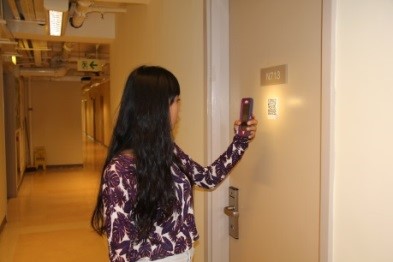
The design of pilot AR-Hall Trail was based on the previous AR-learning trail experience developed by other departments in HKBU (the Trails of Integrity and Ethics – TIEs), and the learning context was written in proper English format. Two individual face-to-face interviews regarding overall the design / experience of this pilot AR-Hall Trail were immediately conducted after two participants had finished his / her learning trails, and their feedback were summarised as below.
- All the learning context should be written in Chinese (i.e. Hong Kong-style Cantonese dialect) since all hall tutors were Cantonese-speaking and they would find themselves easier to be engaged in the given scenarios;
- To incorporate some detective gaming element within the learning context would further arouse students’ interest for the less motivated topic like ‘Hall Rules and Regulations’;
- To embed real life experience within the learning context for better immersing hall tutors’ own identity in the real situation setting;
- To use thought-provoking type of questions within the learning context rather than straight forward type (Yes or No) questions;
- To include ‘Input Boxes’ within the story-line for hall tutors to input their personal responses / reflection on a particular situation.
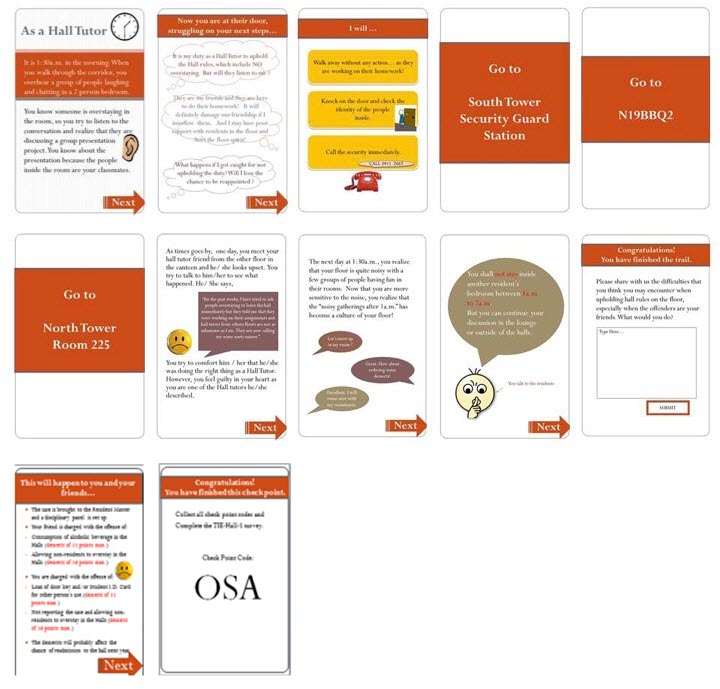
Actual Study (Actual AR-Hall Trail)
Based on the feedbacks collected from the pilot run as described in section 4.1, a new actual AR-Hall Trail was designed for 34 newly appointed hall tutors (AY 2015-16) as part of their Induction Training Programme held in summer 2015. With the use of a detective gaming element, the ‘AR-Learn’ App was re-designed for the deployment of the actual study within the hall environment. Based on our previous experience, the learning context adopted in the actual AR-Hall Trail was stored on a dedicated server in HTML5 format, to make sure the visual displays were consistent across the Android smartphones and iOS devices. By employing “Clickstream Tracking” method, we could record what options a user had clicked (or selected) while web browsing or using a software application. Any action done by the users within the webpage or application was logged (Roebuck, 2011). Therefore, data collected from the Client-side (i.e. Mobile content) by using customized JavaScripts snippets inserted within the HTML5 pages would be processed by the programming scripts written to logging the data which could then export to Excel file for further analytics processing (Chan, Chiu, Ng, & Kwong, 2015).
Steps of Conducting the Actual AR-Hall Trail in the Induction Training Programme
Being a new approach introduced to the existing hall tutor Induction Training Programme, participants of the AR-Hall Trail were asked to follow the FOUR steps as described below for them to get acquainted with this innovative trail.
Step 1: Preparation before the Actual AR-Hall Trail
Participants were first explained how to conduct the actual AR-Hall Trail in a briefing session, before downloading the free ‘AR-Learn’ App (see Figure 2.3). Participants had to answer a Pre-trail Survey as shown in Figure 2.4 for listing the three most difficult things / issues to handle from the perspective as a hall tutor before they started the actual AR-Hall Trail. The Pre-trail Survey aimed to prompt the participants to consider and focus on possible issues so as to better prepare them for the trail.
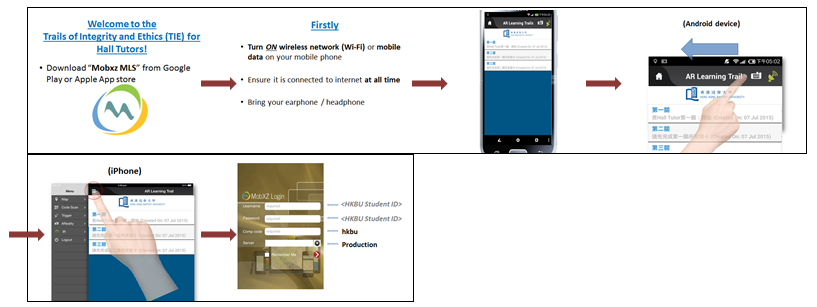
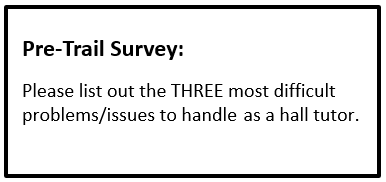
Step 2: Experience on the Actual AR-Hall Trail
The actual AR-Hall Trail was conducted on 10 August 2015 with 27 out of 34 newly appointed hall tutors. The entire learning context was now written in Hong Kong Cantonese dialect with a detective gaming element.
There were altogether 3 stages with 9 checkpoints in the overall story-line style learning trail as shown in Figure 2.5. Participants had to complete all the 3 stages in sequence by going through all the single checkpoints to immerse themselves in the virtual scenario.
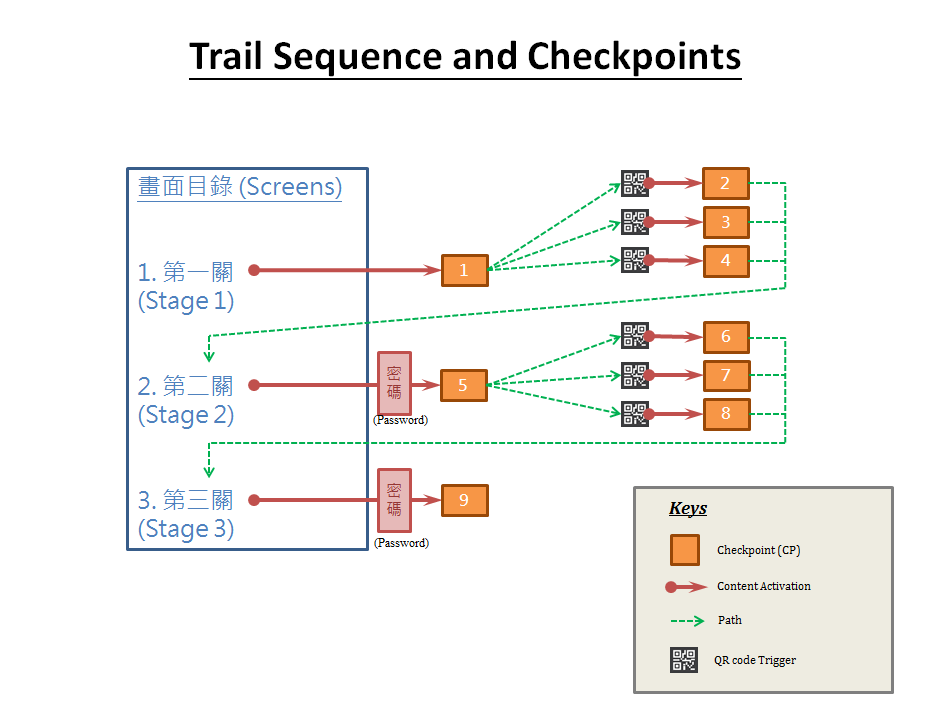
Participants had to move around to different designated locations in the actual AR-Hall Trail and each physical location referred to as a checkpoint # and 9 checkpoints altogether. In addition to the checkpoints, each participant had to respond to 3 different pop-up questions which appeared at checkpoint numbers 4, 7 & 9 (as shown in Figure 2.6). Although it was compulsory for participants to enter short answers for 3 different pop-up questions in order to complete the story-line, the input by the participants was self-paced with no pressure, therefore they could enter their personal feedbacks into the input boxes displayed on their mobile devices in their own time.
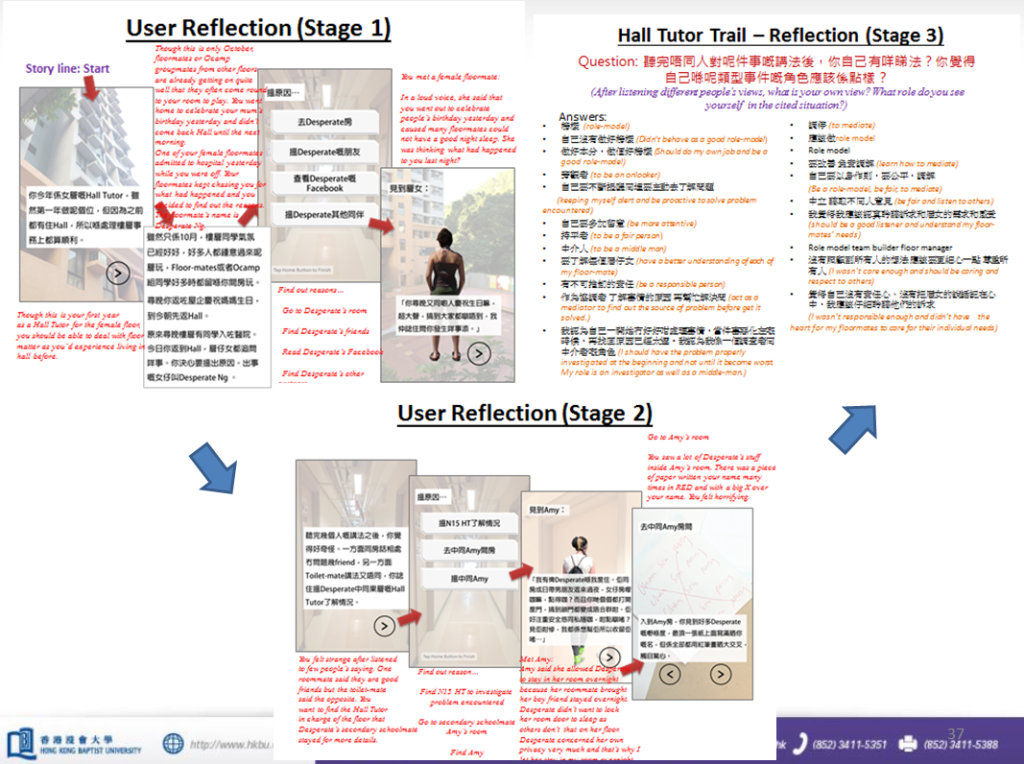
Table 2.2 below has summarised all the qualitative feedback collected at each of the 3 stages that participants had input into their mobile devices during the actual AR-Hall Trail.
Table 2.2
Summary of Participants’ Responses at each of the 3 Stages of Actual AR-Hall Trail
| Issue Explored | Scenario Description | Answers to Questions after Viewing the Stimulated Scenes on the mobile Apps During the Learning Trail | Summary of Input Answers Received at each of the 3 Stages |
| Ethical role of a hall tutor?
|
A hall tutor of a mixed floor went home to celebrate her mum’s birthday and leaving her floor-mates behind for overnight. Loud noise had caused disturbance to her floor mates and there was a floor girl admitted to hospital during her absent of duty. A hall mate questioned the hall tutor what and why did it happen when they met in the corridor? | Participants had to input and express their feeling by answering the 3 pop- up questions as listed below via text boxes displayed on the mobile App during the trail (see Figure 5).
Q1. How do you feel when you heard the comments given by your hall-mates? (Pop up at checkpoint 4 with 27 responses received)
|
Selected Responses Received from Stage 1:
Question: 聽到層女咁講你有咩感受? (請輸入感受 )[What do you feel after listening to your floormate’s comments? (Enter your feeling)] Answers: · guilty · 內疚 [Feel guilty] · 覺得抱歉,對於上述的事情,會進一步了解 [Feel sorry, will follow-up the case described] · 覺得自己照顧唔好層女,想幫佢 [Feel sorry that I did not look after my floormates properly and would like to help them] · 同情及理解 [Feel sorry and understood] · 唔好意思,琴晚真係噪到人,下次會注意聲量 [Feel sorry it last noisy last night and would try to control voice volume next time]
|
| Q2. How do you feel when you see the scene? (Pop up at checkpoint 7 with 24 responses received) | Selected Responses Received from Stage 2:
Question: 見到呢個畫面你有咩感覺? (請輸入感受 )[What do you feel on seeing this this scenario?] Answers: · 錯愕 [Surprise] · 好驚訝 [So frightened] · 有點內疚 [Feel guilty] · 不安,對此情況十分擔心 [Worry & unhappy] |
||
| Q3. What is your opinion after receiving different comments and opinions from your hall-mates? What role do you think you are in such an incident? (Pop up at checkpoint 9 with 26 responses received) | Selected Responses Received from Stage 3:
Question: 聽完唔同人對呢件事嘅講法後,你自己有咩睇法?你覺得自己喺呢類型事件嘅角色應該係點樣?[After listening to different people’s views, what is your own view? What role do you see yourself in the cited situation?] • 作為協調者 了解事情的原因 再幫忙解決問題 [Act as a mediator to understand things and get problem solved] • 應該做role model [Be a role model] • 自己要以身作則,要公平,調解 [Be a role model myself, be fair, justice and mediate between things] • 應要引導層女講出自己感受,並同時要代表全層向其他單位有所交代 [Should encourage floormates to share their feelings and share their concerns to other relevant floors] • 我錯左 應該同佢道歉 而應該執番正做 [I should admit my wrong doings, apologise to my floormates and correct my mistakes] |
Step 3: Post Actual AR-Hall Trail Arrangement
A post actual AR-Hall Trail survey (as shown in Figure 2.7) and an AR mLearning “Usage Experience Survey” (see Figure 2.8) were also conducted for those 27 hall tutors immediately after they finished the trail. The Post-Trail Survey was used as a means to assess whether the experience and learning through the AR trail had achieved the objectives of enabling the hall tutors to personalize their ethical thinking in performing their roles and responsibilities, in particular their responsibility in implementing hall rules and their role as role models to their peer residents.
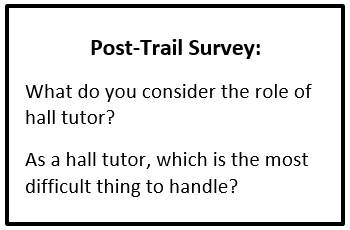
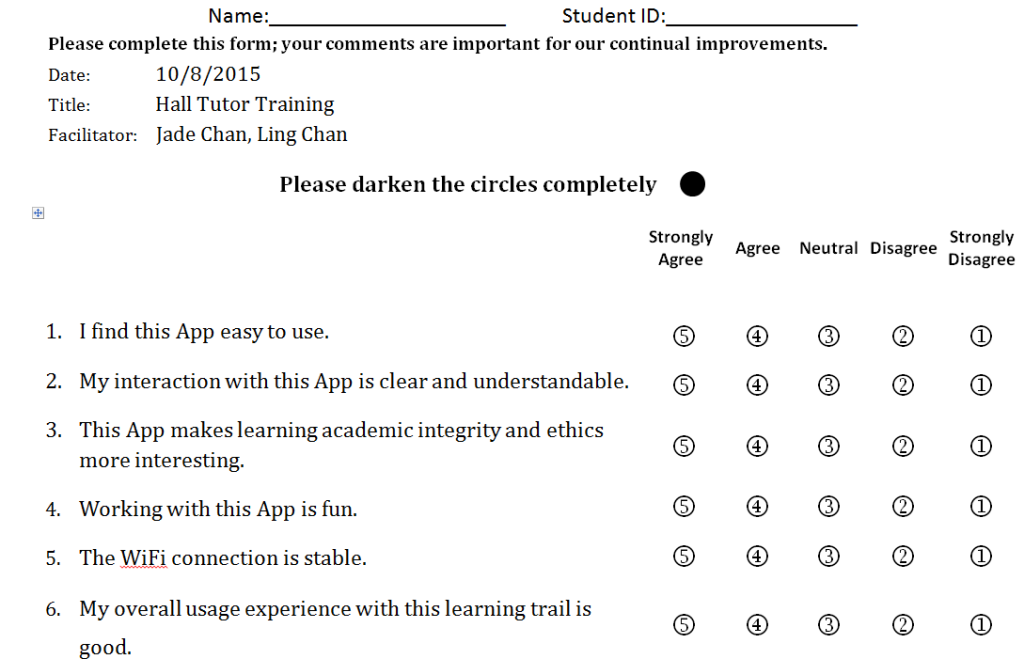
Step 4: Follow-up Interviews Nine Months (towards the End of Hall Tutors Service Period) After the Actual AR-Hall Trail
The reason of having follow-up interviews nine months after conducting the actual AR-Hall Trail was to evaluate the impact of using the AR-Hall Trail and whether the impact was sustainable. It would be an objective measure of the effectiveness of the trail as the hall tutors then had been in their positions for nine months and they could genuinely assess if the experience and learning through the trail indeed had helped them to perform their role as hall tutors. Three 30-minutes focus group interviews were arranged on 5, 7 & 8 April 2016, with 7 females & 2 males hall tutors with a total of 9 out of 27 (~33%) for AY2015-16, who had participated in the actual AR-Hall Trail held in August 2015. These interviews therefore aimed to collect feedbacks from the perspective of participants regarding the effectiveness of the AR-Hall Trail and provided evidence on the sustainability of the learning trail.
Data collected from the Pre- and Post-Trail surveys were analysed by using an Open Source Search Results Clustering Engine called Carrot2 that automatically generated common words and phrases from the input data, which could then be visualised into the format of a Foam Tree diagram. The data would be further analysed by using text-mining approach called Latent Dirichlet allocation (LDA) to verify the number of occurrences (key words) of those input data. Data collected from the focus group interviews were summarised under different interview questions.
Data Collection and Analysis
There were two different sets of Pre- and Post-Trail surveys conducted in this study. The purpose of the Pre-Trail survey was to prompt the participants of possible issues encountered as hall tutors, whereas the Post-Trail survey was to assess the impact of the trail in achieving the objectives of deepened ethical thinking in terms of their roles and responsibilities as hall tutors. The results collected from the Pre-Trail survey were analysed as shown in Figure 2.9 (Pre) by using an Open Source Search Results Clustering Engine called Carrot2 that automatically generated common words and phrases from the input data, which could be visualised into different display formats like the Foam Tree Diagram. In Figure 2.9 (Pre) it could be seen that phrases like ‘Relationship’, ‘Hall Rules’, ‘Dispute’, ‘Cultural Differences’, & ‘Cleanliness’ etc. had the most frequent occurrences in the diagram, which could be interpreted that before the actual AR-Hall Trail ‘Relationship’, ‘Hall Rules’ and ‘Dispute’ were considered the three most difficult issues for the hall tutors to handle.

After experiencing the actual AR-Hall Trail within the situated hall environment in participants’ own time, data collected from the different Post-Trail Survey (see Figure 2.7) had illustrated a vastly different Foam Tree Diagram, as shown in Figure 2.9 (Post) above, since the participants were now asked to consider their role as a hall tutor and what was the most difficult thing to handle. From Figure 2.9 (Post), it could be observed that the most prominent phrases associated with “role” were ‘Role Model’, ‘Storey Manager’ and ‘Team Builder’; whereas issues like ‘Time Management’, ‘Conflicts’ and ‘Dispute’ also appeared. It could be interpreted that after the trail most hall tutors considered being a role model as their most important role, and time management was the most difficult thing for them to handle. As observed from Figure 2.9 (Post), the area allocated to the term ‘Role Model” is considerably larger than the others, reflecting that after the trail the hall tutors viewed their role and responsibility as of greatest importance. These results therefore suggest that the AR-Hall Trail allowed the participants to sharpen their ethical thinking to real-life settings as they became more aware of their ethical role as role model to their fellow hall residents, but without losing sight on dealing with issues like good time management and resolving conflicts.
It could also be observed that most participants were very much engaged during the AR-Hall Trail as reflected from the short answers they responded to those pop-up questions within the ‘AR-Learn’ App as summarized in Table 2.2. Qualitative results summarised in Table 2.2 provided evidence that based on the scenario-driven with a story-line in the actual AR-Hall Trail had strengthened participants’ ethical thinking as the role of a hall tutor which verified the quantitative findings obtained from the Post-trail survey as illustrated in Figure 2.9 (Post). The responses collected from the participants revealed that through the story-line virtual scenarios they had taken on their role as a hall tutor, and they realized that their actions and responses could lead to negative or unanticipated consequences (as found in phrases like ‘surprise’, ‘feel sorry’, ‘guilty’ etc). This awareness in return strengthened their ethical responsibilities like ‘be fair and act as mediator’, ‘to share floormates’ feelings and take responsible action’, ‘apologize and correct the wrong doings’ etc, as summarized in Table 2.2. Their inputs also suggested that not only they understood their role as a hall tutor but also recognized the possible consequences of their actions and the effects upon others (Sharipova & McCalla 2013).This kind of change in thinking was to reaffirm that knowledge has transferred (Azuma et al., 2001; Dede, 2009; Johnson et al., 2011) as a result of an “immersive” learning experience through a situated learning environment with the adoption of AR technologies under a time-free control setting.
With the help of our sister institution, the Hong Kong Education University, the collected Pre- & Post-trail data were further analysed by using text-mining approach called Latent Dirichlet allocation (LDA) to counter checking the number of occurrences of those key words collected from the Pre- and Post-trail surveys by generating histograms as shown in Figure 2.10. The higher the bars, the higher frequency of occurrences of those collected words/issues. LDA therefore could be used to confirm the analyses and observations made using the method of Carrot2 as illustrated in Figure 2.9. As shown in Figure 10 (Pre) the hall tutors before the actual AR-Hall Trail were only concerned on superficial issues with key words such as ‘Relationship’, ‘Resident’, ‘Hygiene’, ‘Dispute’, ‘Hall’ and ‘Rule’ having the highest frequencies of occurrence (circled in red). On the contrary, after the actual AR-Hall Trail key words like ‘Role’, ‘Model’, ‘Builder’, ‘Manager’ had relatively high frequency of appearance which were all associated with the roles of a hall tutor whereas ‘Time’, ‘Management’ were the only the key words with relatively high frequency of occurrence (see Figure 2.10 (Post) and circled in blue), which again reaffirmed previous findings from Figure 2.9 (Post) and Table 2.2. This once again illustrated that there was a change in ethical thinking of most participants due to their ability of transferring the learning content in the virtual trail into real-life settings.
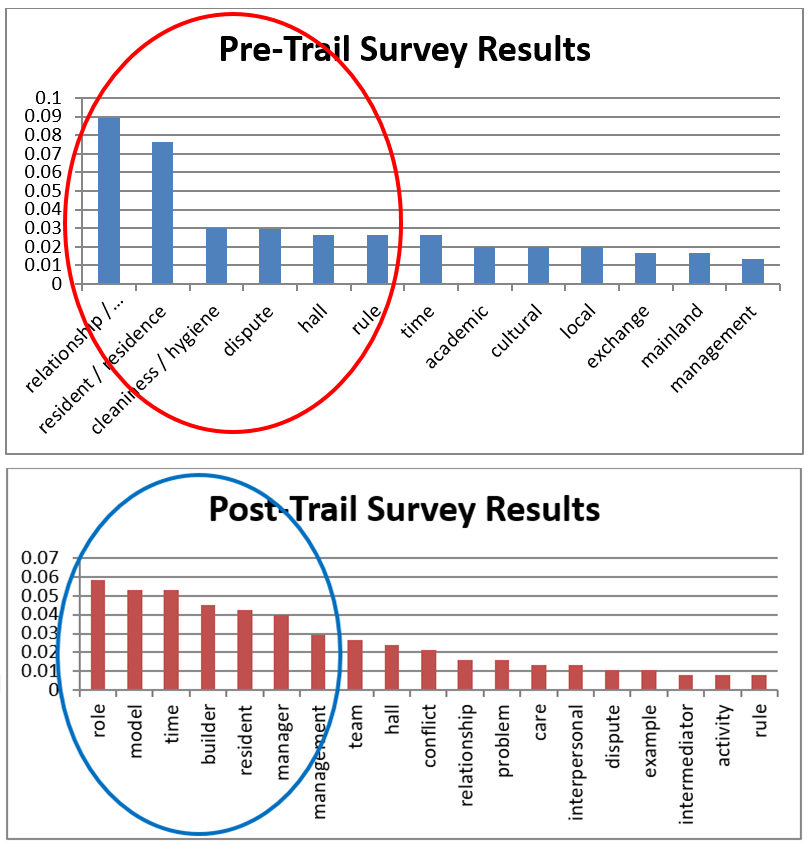
Moreover, results collected from the focus group interviews with 9 participated hall tutors nine months after their actual AR-Hall Trail, summarised in Table 2.3 below, had shown that this kind of AR-Hall Trail was more effective in learning ethical concepts than in the traditional classroom setting. For example, the participants agreed that the AR-Hall Trail was an innovative approach with fun, and that they were more engaged and motivated to learn. They also provided constructive suggestions on ways to improve future AR-Hall Trail, reflecting that they fully enjoyed the learning process. The response from the hall tutors also demonstrated that even nine months after the actual AR-Hall Trial, the hall tutors could still recall what they had learnt from the trail indicating that its impact was sustainable.
Table 3
Summary of Focus Group Interview Results with 9 Hall Tutors (AY2015-16)
| Questions on Focus Group Interviews with Current Hall Tutors | Summary of Interview Results of 3 Focus Groups with 9 Hall Tutors |
| Q1. Do you remember what had happened during the last AR training? | Yes, regarding hall rules. |
| Q2. Do you think the student-driven AR training help you internalize your role as a hall tutor? Why?
|
An innovative way to learn hall rules in a familiar hall environment and more fun. Hall tutors were engaged and motivated when they followed the given virtual scenario with horrifying sound effect and graphics – allowed them time to think what they should do as a role of hall tutor in the real situation.
|
| Q3. How did the context used by the trail help you to experience the reality? Give examples.
|
More real life cases with more checkpoints and with different consequences after answering different questions would help. The App could be designed with more dynamic options for choices. |
| Q4. Is the past experience living in the Hall of Residence help you on identifying yourself in the situation as cited in story-board trail? Why? | Yes, the past experience of living in the hall of residence could engage participants easier and allow them to immerse in the virtual scenario as described. |
| Q5. Do you think the use of AR together with mobile technologies as part of your hall tutors training appropriate? If yes, go to Q6 otherwise. | It was more fun to adopt AR as part of the hall tutor training since participants could move around with their mobile devices rather than just sat and listened to the instructor in the classroom setting. The scenarios used in the App could have more provoking questions for one to think even deeper. |
| Q6. Any suggestion(s) for better improvement of the trail design next time?
|
General:
– QR code scan was too easy to find; – Longer, deeper thematic story-line was expected for hall tutors to think more; – Suggested to apply similar AR training on freshmen for better learning outcome. Technically: – The QR code pop-up unintentionally; – WiFi connection was okay. |
| Q7. Any suggestion(s) on the type(s) of training to better identifying the Roles and Responsibilities as a hall tutor in addition to the use of mobile technology? | – The story-line could be longer and deeper for participants to think deeply.
– The scenario may include more characters like resident master, resident coordinator and administrative staff etc |
Discussion and Conclusion
With the concerted effort of different dedicated professional staff and student leaders in the university, the application of AR mLearning technologies with student-oriented design of the ‘AR-Learn’ App conducted within a context-/location aware hall environment seemed to have produced constructive feedbacks. The positive learning outcomes of this study has supported what Doppelt, Mehalik, Schunn, Silk and Krysinski (2008) reported that learning by design could improve student learning outcomes as students understanding of their world was best developed when they actively created real objects (Papert & Harel, 1991).
The pilot AR-Hall Trail findings had provided helpful insights to the actual AR-Hall Trail design (Yue, et al, 2016) including but not limited to localised language used for the mobile context, complexity of story-line, scenario-driven, provision of inputting personal feedback, etc. The use of AR technologies in this study helped many participants learned by placing learning content in rich contextual settings that more closely mirrored real-world situations in which new knowledge has been applied as described by Johnson et al. (2016). Moreover, this study was also carried out in line with the constructivist theory of learning that an augmented environment had moved from an instructor-centered environment to a student-centered one where students had constructed new information based on their prior learning experience. According to Dunleavy and Dede (2013), AR as an epistemic tool and educational approach was consistent with situated and constructivist learning theory. It transported students to a real-world physical and social situation with instructing, scaffolding, facilitating participatory as well as metacognitive learning taken place simultaneously.
Many participants in the study preferred this kind of innovative training than just listened to instructions in a classroom setting as revealed in their focus group interview results nine months after they had conducted the actual AR-Hall Trail as summarized in Table 3. The participants also gave suggestions for future improvement of the trail which include more special sound effects, thematic real-life scenarios, longer story-lines etc. in the mobile App design to further engage participants’ cognitive understanding on ethical concepts. More stable network access like Wi-Fi to accommodate a larger number of participants was also recommended.
This study has therefore successfully enhanced many participants’ deeper ethical thinking as residential student leaders in the Induction Training Programme, as suggested by Johnson et al., (2016, p.40), because they once again realised the importance of behaving as role models to their fellow residents, as discussed in section 5. This was the very first time that the “Hall Life Education Team” in HKBU carried out such a creative attempt in using AR mLearning application on enhancing residential student leadership training with expected learning outcomes, which a traditional classroom setting may not be able to do so. Such learning trails would be repeated in the coming years so as to collect a larger sample size to verify the consistency of the results obtained. Also similar learning trails would be recommended for the residential education in other local or overseas universities.
